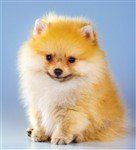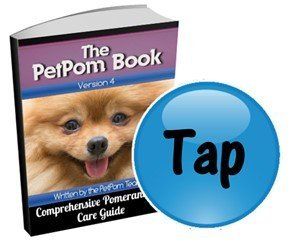House Training Your Pomeranian
Overview
Pomeranians are rather good with training; whether it is for housebreaking, heeling, or performing tricks.
When it comes to house training, this will be a combined effort between the two of you. It will be a partnership in learning. You'll take the important role of teacher, and your Pom will be a great student, as long as you follow all of the necessary guidelines.
Here, we'll cover the elements that you'll need to know in order to help your Pom puppy or un-trained older dog be successful.
Please note:
PetPom is reader-supported, and some of the product suggestions on this page are affiliate links. As an Amazon Associate we earn from qualifying purchases. This is at no extra cost to you and helps us continue providing free, high-quality information.
When to Start Housebreaking
This
excludes
any other dogs that you may have, as long as you are 100% positive that they are fully up-to-date on vaccinations.
So, do keep this in mind when you choose a spot as the designated area for your Pom to potty in.
With older dogs:
It's not uncommon for an adult to find his way to a new home; whether this is through a shelter, a rescue, or a re-homing of another sort. Even if you have been told that the Pomeranian is housebroken, you will still want to follow through with all of the training steps.
This is because you will want to be sure that your Pom understands your rules and where his bathroom area is. Too many owners of adult dogs just assume that the dog will alert them to their bathroom needs; however, you may find out the hard way that this is not true. Your Pom will need to be taught the rules that are in place under your
roof.
How Long it Takes to Housebreak a Pomeranian
Pomeranians are pretty fast learners; however, the time that it takes for a Pom to be 100% fully housebroken will depend on a few factors.
Two of the most important elements will be how strictly you stick with the training and how many learning opportunities the Pom has. Therefore, a lot of this depends on you.
It will be important for you (and anyone else in the house that is responsible for your Pom) to follow the housebreaking guidelines to a tee. And to take advantage of every chance to teach these important lessons.
In busy households in which a Pom does not have guidance for most of the day, housebreaking can still be done, but will often take longer than in a house where an owner is home most days.
This all said, it will typically take 2 to 4 months for a Pomeranian to be fully house trained.
Indoor Vs Outdoor
It is a popular notion that toy breed dogs can easily be trained to use a litter box or pee pads. While this is possible, this is not as easy as it sounds. A puppy may resist or have a hard time using pee pads because canines have a natural instinct to want to 'choose just the right spot' to urinate or eliminate.
However, indoor training can be done if you are persistent and you have a puppy that is cooperative.
We recommend the outdoor housebreaking method, unless there are extenuating circumstances that prevent you from taking your Pom outdoors.
To keep things simplified going forward, we will refer to your chosen spot as the 'designated bathroom area', and this will be the term used whether you have pee pads set up in a corner, have an indoor grass mat for your Pom, or are training outside.
Preparing to Housebreak Your Pomeranian
Your Pomeranian should be brought to that same area each and every time you take him out.
Here are some tips on choosing where to bring your Pomeranian to go to the bathroom:
- Consider all of the seasons. What may be easily accessible in the spring may be hard to reach in the winter. If you live somewhere that receives snow or bad weather, choose a spot that you can easily reach no matter what.
- Do not have this be close to a busy outdoor family area. If you have an outside spot that is frequently used for barbecuing or for kids to play, you'll want to pick a place that is at least 10 feet away.
A Pomeranian that is not fully housebroken should never be allowed free reign in either a room or the house if he is not being supervised. If you allow this, there will inevitably be puddles of pee and little piles of poo all over your home.
And, every single time that a dog urinates or defecates inside the house is a step backward in the wrong direction.
In addition, if your Pomeranian sleeps with you and pees on your bed, having your Pom is his own area will eliminate that problem as well. While it's always pleasant to cuddle up with your best friend, untrained puppies and dogs should not be allowed in the bed; to do so is just asking for trouble.
Another plus to creating a contained area is that is an important part of setting up the right environment for when your dog is home alone. When a dog has a defined space that contains his supplies, it speaks to his canine need to have a 'den'. It immediately brings about feelings of security.
One of the best methods for house training containment is to have an indoor canine playpen. Note that this is not a crate. Crates are terribly confining, lend zero aid towards housebreaking, usually lead to a Pom stepping in his own feces and urine, and can cause both physical and emotional stress.
Within the playpen, will be 4 areas: A bed, food & water bowls, a toy area, and importantly the 4th area that will be for pee pads. Since dogs will rarely soil their own belongings, chances are high that pee and poo will be deposited onto the pads.
So, you will find that a great playpen like the Iris 4-Panel Pet Playpen with a Door
 is a valuable tool for training, as well as where you will want your Pom to be when you are away from home (at least until he is fully housebroken and/or he does not have separation anxiety).
is a valuable tool for training, as well as where you will want your Pom to be when you are away from home (at least until he is fully housebroken and/or he does not have separation anxiety).
#3 Have a supervision method. This is for all times that you are with your Pom inside the house and will be supervising the pup.
It's far too common that an owner will be 'watching' their Pom, but then the pup scampers away behind the sofa or around the corner. You may be right on the trail, but when you jog over to grab him, there's already a puddle of pee.
The best method to keep your Pom right by your side is to literally make it impossible for this not to happen. And that can be accomplished by tethering your Pom to you via a harness and a 4 or 6 foot leash.
Note that you will want to use a harness to prevent possible neck injury. A good one to use is the Lil Pals Mesh Comfort Mesh Adjustable Harness , which fits even tiny pups, is super comfortable, is easy to put on and off, and allows for good air flow.
, which fits even tiny pups, is super comfortable, is easy to put on and off, and allows for good air flow.
And, you will want the leash to be lightweight and soft-handled like the Coastal Dog 4 Foot Leash . The soft handle will allow you to slip the handle around your wrist, or slip it through a belt loop on your slacks.
. The soft handle will allow you to slip the handle around your wrist, or slip it through a belt loop on your slacks.
A couple recommended treats for house training include Fruitables Pumpkin & Blueberry Crunchy Dog Treats , which are made in the USA, are ideally sized for toy breed dogs, have no extra additives, and are well received due to their pretty great flavors. Aside from the pumpkin and blueberry, there is also pumpkin and banana, apple, and cranberry.
, which are made in the USA, are ideally sized for toy breed dogs, have no extra additives, and are well received due to their pretty great flavors. Aside from the pumpkin and blueberry, there is also pumpkin and banana, apple, and cranberry.
Another good choice to send a strong signal of a job well done is Wellness Bites Grain-Free Puppy Training Treats , which are perfectly sized, have no wheat or grain, come is super-tasty flavors like lamb & salmon or chicken & carrots, and are made in the USA.
, which are perfectly sized, have no wheat or grain, come is super-tasty flavors like lamb & salmon or chicken & carrots, and are made in the USA.
2)
Keep a small plastic bag of your chosen training treat right by the exit door. There will be times when you are hurrying out with your Pom for immediate bathroom needs, and you do not want to be wasting time in getting them.
Also, keep the sandwich bag zipped up so that your Pom does not smell them beforehand.
#5 Choose the cue words.
Dogs learn best when the can make the connection between word(s) and actions. So, it will be important to decide on a phrase that will be spoken each time you take your Pom out to the bathroom area.
You'll want this to be a short phrase (since dogs pay little attention to anything passed a few syllables), and you'll want everyone in the house that may take your Pom out to be on the same page about which phrase will be used.
Some common cue words to use include 'Go potty', 'Potty time', 'Pitty-potty', and 'Get busy'.
To Summarize Your Prep:
How Often to Take a Pomeranian Out

Teddy, photo courtesy of Janet & Don Chrosniak
Housebreaking Tips
Once you are sure that you are fully prepped, and everyone that takes care of your Pom is on the same page, it will be time to start housebreaking. Here is some helpful advice. Some of this will be slightly repeated from above, so that it is in an order that makes sense.
1.
Keep your Pom with you, by your side as often as possible. If there is a motion to pee or poo, clap your hands loudly and/or call out his name to cause him to pause.
It does not help to yell out 'No!' if your Pom has only started to squat or lift a leg. Because, after all, a puppy cannot be 'wrong' for having the urge to urinate or eliminate.
2.
Your prep (as discussed above) should allow you to exit with your Pom quickly, but carry him if you must.
3.
As you head to the area and
as your Pom is doing the deed, repeat the cue words, so that your Pom can make an association with his actions.
4.
Allow your Pom a good 15 minutes to find the perfect spot within the designated area, and for his bowel and bladder muscles to relax.
As a pup matures, he will be able to release his needs much faster, but puppies can take a while.
If you do not allow for this time, and you go back into the house too early, your Pom may very well be ready to pee or poo soon after he's back inside.
5.
If your Pom pees and seems to be done, offer the reward treat right away. Give praise at the same time as you give the treat.
The praise will be the word 'good' along with your chosen word for bathroom trips. So, for example, "Good piddy potty".
If you are not sure if he is done, offer the reward and allow him the rest of the time window to see if he also needs to poo.
If he has pee'd, and seems to be sniffing around to poo, hold off on the treat so that he is not interrupted. But then give it to him as soon as the session is complete.
6.
If there are any accidents in the house, it is important to clean the area with an enzyme cleanser. If you only use soap and water it will not eliminate trace odors. You will not be able to smell them. But, it will be akin to 'This is the bathroom area!' being announced to your puppy or dog.
We like Pet Stain & Odor Miracle Enzyme Cleaner , as it is a very effective cleanser for both pee and poo.
, as it is a very effective cleanser for both pee and poo.
Marking - Marking is a common issue with all dog breeds. You will know it is marking and not a house training issue if your Pom always does this in the same spot and does not fully empty his/her bladder, only spraying out just a bit. To learn more about this, you may wish to read our
Marking section.



-min-320x320-1920w.jpg)
-min-276x335-1920w.jpg)
-min-240x335-1920w.jpg)
-min-320x327-1920w.jpg)

